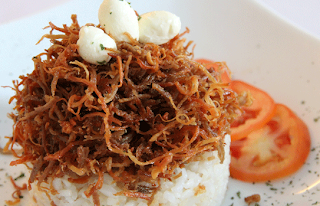Since every Filipino is easy to adapt to any environment, especially in foods that they are eating. Here in our country (Philippines), Korean restaurant is like a mushroom that sprouting everywhere, especially in an urbanized area. Every time I have a chance to visit Korean restaurant with my friends and family, there is a menu that I always looking for.
Showing posts with label Pork Recipes. Show all posts
Showing posts with label Pork Recipes. Show all posts
Pork Sinigang (Sinigang na Baboy) Recipe
Filipino Cuisine Main Dishes Pork Pork Recipes Pork Sinigang SInigang na Baboy Soup Sour Soup
Pork Sinigang or "Sinigang na Baboy" or pork stew, it is sour and savory taste most often associated with tamarind (sampalok) popular in the Philippines and is related to the Malaysian dish "Singgang".
Nilagang Baboy (Boiled Pork with Vegetables) Recipe
Filipino Cuisine Filipino Style Main Dishes Nilaga Pork Pork Belly Pork Recipes
Nilagang Baboy - consider as one of the comfort food of every Filipino family during rainy and cold season. The yummy hot soup taste of the dish from the pork, vegetables and herbs gives more relaxing and enjoyable eating time. This is simple and easy to prepare, it's just boiled the meat into water until tender and add the selected vegetable of your choice.
Pork Tapa Recipe
Cured Pork Pork Pork Recipes
Pork Tapa is another variety of "tapa", refers to cured meat slices, the meat can be beef, pork or even chicken. Tapa is usually served during breakfast with fried rice and egg together with "achara" (picked papaya strips) or spicy vinegar.
Homemade Pork Tocino Recipe
bacon Cured Pork Filipino Cuisine Filipino Style Pork Pork Recipes Tocino
Tocino is typical meat sliced into thin strips cured in anise wine, annatto, water, salts sugar and saltpeter mixture, stacked in a separate container,and covered and kept refrigerated for about three days to cure. But the original tocino is marinated only with salt, sugar, and saltpeter.
In Spanish, Tocino is bacon, made from the pork belly, and some other countries in Caribbean, is made from pork fatback and neither cured nor smoked and fried until very crunchy.
Adobo Flakes Recipe
Adobo Adobo Flakes Chicken Chicken Recipes Pork Pork Recipes
Do you have a left over adobo from your previous meal and you do not want to served it again? Why not turn into another dish by creating a little twist with your leftover adobo to a crispy Adobo Flakes.
Adobo flakes is made of toasted adobo using any meat like pork, chicken, beef and even fish. cooking adobo flakes is very simple and you can add toasted garlic for additional flavor to your crunchy and crispy flakes.
Filipino Style Pork Barbecue Recipe
Grilled Grilled Pork Grilling lasangrecipes Pork Pork Recipes Pork Barbecue (BBQ) is typically marinated of pork in special sauce and speared in bamboo skewers and grilled.
Pork Barbecue (BBQ) is typically marinated of pork in special sauce and speared in bamboo skewers and grilled.
In the Philippines, there are many varieties of barbecue (pork, chicken and fish). Many Filipino's eat barbecue as an appetizer, meal, and snack, this traditional dish is commonly available along the street in the metro and even served in restaurant, bars and food chains.
Tokwa't Baboy (Pork and Tofu) Recipe
Appetizer Pork Pork Recipes Tofu Tokwat baboy
This dish is usually made from boiled pork (usually they used either or both pig's ear and pig face part and something pork belly), fried tofu and sauce from soy-sauce vinegar and other spices that gives life to our Tokwa't Baboy. |
Igado (Filipino Pork Meat and Liver Stew) Recipe
Filipino Cuisine Ilocano Dishes Pork Pork Recipes StewThere are variations of igado that include ingredients like fried potatoes, carrots, and green peas. Some have little but thick sauce which gives a dry texture to the dish. Others are prepared like a soupy dish, which should be ideal for places where the weather is cold. |
Humba (Braised Pork Belly) Recipe
Filipino Cuisine Humba Pork Pork Belly Pork Recipes Visayan DishesIn this Filipino pork dish, the traditional way of cooking humba is to slowly simmer of pork belly in a mixture of pineapple juice, tausi (salted black beans), vinegar, dark brown sugar, garlic, onions, peppercorns, dried banana blossoms and oregano. |
Lechon Paksiw Recipe
Filipino Cuisine How to cook lechon Pork Pork RecipesA delicious Lechon paksiw lies on the sauce used in this recipe. I included in my blog on how to prepare Lechon sauce. |
Dinuguan (Pork Blood Stew) Recipe
Dinuguan Filipino Cuisine Main Dishes Pork Pork RecipesDinuguan is usually served with white rice or a Philippine rice cake called puto. |
Picadillo (Beef or Pork Giniling) Recipe
Beef Beef Recipes Filipino Cuisine Main Dishes Pork Pork Recipes Tomato SauceEmbutido (Filipino meatloaf) Recipe
Filipino Cuisine Meatloaf Pork Pork Recipes Steam Steam Recipes|
An Embutido is a generic term for sausages found in Spain, Portugal, the Philippines, and Central and South America. There are several type of embutido all over the world. Generally, embutido contains hashed meat, generally pork, seasoned with aromatic herbs or spices (black pepper, red pepper, paprika, garlic, rosemary, thyme, cloves, ginger, nutmeg, or others) that is served wrapped in the skin of the pig's intestines |
Soimai Recipe
Beef Beef Recipes Chinese Cuisine Filipino Cuisine Pork Pork Recipes SteamBagnet (Deep-Fried Pork Meat) Recipe
Deep Frying Filipino Cuisine Ilocano Dishes Pork Pork Belly Pork RecipesThis dish takes few easy steps to complete and will just take you 1.5 hours to prepare. |
|---|
Subscribe to:
Posts (Atom)
















